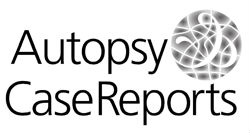Sister Mary Joseph nodule: it does not bode well
Stephen A. Geller; Fernando P. F. de Campos
Abstract
Sister Mary Joseph’s nodule (SMJN), was at the time of its description, recognized as metastatic disease.
Histologically, SMJNs are predominantly adenocarcinoma (75% of the cases), mostly metastatic from primary gastrointestinal (GI) tract or gynecological sites (12-15%) and, as in the case shown here, mucus-secreting.
In the GI tract the stomach is the leading malignant primary site, followed by colorectal and pancreas (more often the body and tail, rather than the head), whereas ovarian serous papillary cyst adenocarcinoma is the most common site in females.
SMJNs may be diagnosed on routine physical examination, during surgical workup or may represent the patient’s presenting complaint. In some series
Differential diagnosis should include benign causes such as endometriosis, melanocytic nevi, dermatofibroma, fibroma, urachal duct cyst, pilonidal sinus, keloid, foreign body, granuloma, myxoma, omphalitis and umbilical hernia,
SMJN usually represents widespread advanced cancer and therefore is associated with poor prognosis, almost always indicating inoperability although, particularly with direct extension from a primary site, this may not always obtain. Depending on the patient’s general conditions as well as the characteristics of the primary neoplasm, the mean survival time is approximately 11 months. Fewer than 15% of patients survive more than 2 years after diagnosis.
Keywords
References
Yusuf M, Azhar R. Umbilical metastasis from oesophageal squamous cell carcinoma: a case report. Internet J Gastroenterol [internet]. 2004 [cited 2014 July 20];3(1):1. Available from: http://ispub.com/IJGE/3/1/10047" target="_blank" title="http://ispub.com/IJGE/3/1/10047">http://ispub.com/IJGE/3/1/10047">http://ispub.com/IJGE/3/1/10047">http://ispub.com/IJGE/3/1/10047
Publication date:
01/13/2016

